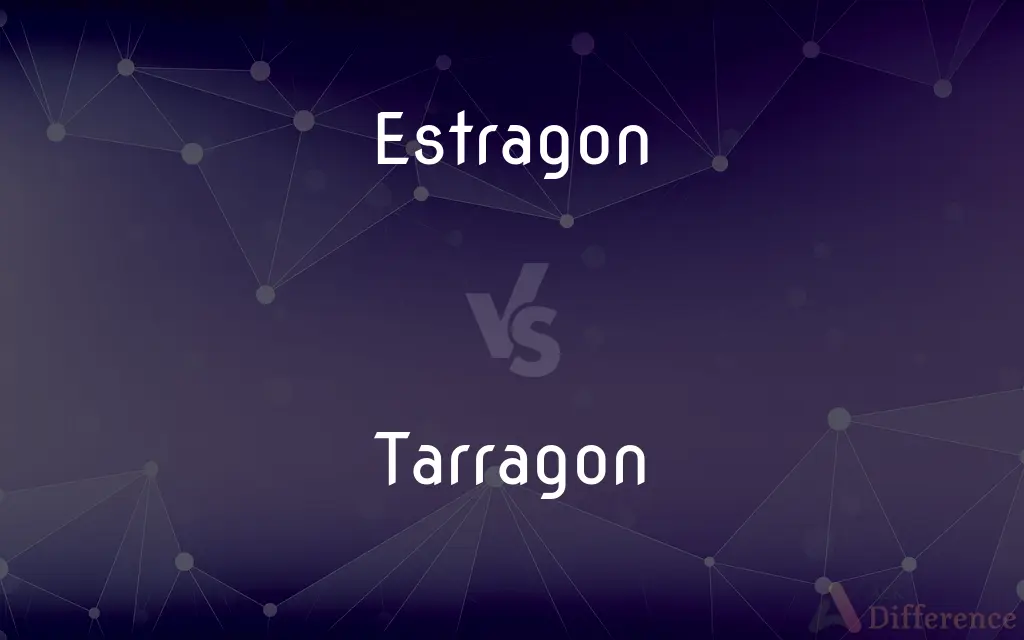Estragon vs. Tarragon — What's the Difference?
By Tayyaba Rehman & Maham Liaqat — Updated on April 17, 2024
Estragon is another name for tarragon, a culinary herb with a distinctive licorice flavor, often used in French cuisine.

Difference Between Estragon and Tarragon
Table of Contents
ADVERTISEMENT
Key Differences
Estragon, known in English as tarragon, is a perennial herb in the sunflower family, famous for its aromatic leaves. Whereas, when referring specifically to 'tarragon,' it denotes the same herb but emphasizes its use and varieties in culinary contexts.
Estragon is particularly noted for its narrow, pointed leaves and a subtle anise-like flavor, which is a staple in many French dishes. On the other hand, tarragon is categorized mainly into French and Russian types, with the French variety being milder and preferred for cooking.
In herbal medicine, estragon is used for its potential digestive benefits and as a sleep aid. Conversely, tarragon is often highlighted for its rich supply of phytonutrients and antioxidants.
Culinary applications of estragon include flavoring vinegar and seasoning chicken, fish, and egg dishes. Tarragon, similarly, is integral to béarnaise sauce and various French cuisines, showcasing its versatility.
The cultivation of estragon requires a warm, sunny environment with well-drained soil, highlighting its growth needs. In contrast, tarragon, particularly the Russian variety, is more tolerant of poor soil conditions and colder climates.
ADVERTISEMENT
Comparison Chart
Common Name
Tarragon
French and Russian Tarragon
Flavor
Subtle, licorice-like
French is milder; Russian is more robust
Culinary Use
Seasoning in French cuisine
Essential in béarnaise sauce, diverse in use
Medicinal Benefits
Digestive aid, sleep aid
Antioxidants, phytonutrients
Growing Conditions
Needs warm, sunny, well-drained soil
Russian variety tolerates poorer, colder conditions
Compare with Definitions
Estragon
A perennial herb with a licorice-like flavor.
Estragon is a key ingredient in traditional French cooking.
Tarragon
Rich in phytonutrients.
Tarragon contributes beneficial antioxidants to the diet.
Estragon
A staple in herbal gardens.
Estragon is often grown for both its culinary and medicinal properties.
Tarragon
A versatile culinary herb.
Tarragon is used to make béarnaise sauce.
Estragon
Essential for flavoring vinegars.
Estragon vinegar is popular in French cuisine.
Tarragon
Grows in varied climates.
Russian tarragon is hardier and more tolerant of cold than French tarragon.
Estragon
Used in medicinal teas.
Estragon tea can help soothe an upset stomach.
Tarragon
Comes in French and Russian varieties.
French tarragon is more flavorful than its Russian counterpart.
Estragon
Thrives in sunny environments.
Estragon needs full sun to develop its full flavor.
Tarragon
Can be used in perfumery.
Tarragon oil is occasionally used in aromatherapy and perfumes.
Estragon
Estragon (affectionately Gogo; he tells Pozzo his name is Adam) is one of the two main characters from Samuel Beckett's Waiting for Godot. His name is the French word for tarragon.
Tarragon
Tarragon (Artemisia dracunculus), also known as estragon, is a species of perennial herb in the sunflower family. It is widespread in the wild across much of Eurasia and North America, and is cultivated for culinary and medicinal purposes.One subspecies, Artemisia dracunculus var.
Estragon
Tarragon
Tarragon
An aromatic Eurasian herb (Artemisia dracunculus) in the composite family, having linear to lance-shaped leaves and small whitish-green flower heads arranged in loose spreading panicles.
Estragon
Aromatic perennial of southeastern Russia
Tarragon
The leaves of this plant used as a seasoning.
Estragon
Fresh leaves (or leaves preserved in vinegar) used as seasoning
Tarragon
A perennial herb, the wormwood species Artemisia dracunculus, from Europe and parts of Asia.
Tarragon
The leaves of this plant (either fresh, or preserved in vinegar / oil mixture) used as a seasoning.
Tarragon
A plant of the genus Artemisa (Artemisa dracunculus), much used in France for flavoring vinegar.
Tarragon
Aromatic perennial of southeastern Russia
Tarragon
Fresh leaves (or leaves preserved in vinegar) used as seasoning
Common Curiosities
How does French tarragon differ from Russian tarragon?
French tarragon has a milder, more delicate flavor compared to the more robust taste of Russian tarragon.
How is estragon used in cooking?
Estragon is commonly used to flavor vinegars, as well as in chicken, fish, and egg dishes.
What dishes are best made with tarragon?
Tarragon shines in béarnaise sauce and is excellent with poultry, fish, and egg dishes.
What are the health benefits of tarragon?
Tarragon is rich in antioxidants and phytonutrients, which may benefit heart health and digestion.
Can you grow estragon in any type of soil?
Estragon prefers well-drained, fertile soil and a sunny location to thrive.
Is tarragon easy to maintain?
French tarragon requires more care regarding soil and climate, whereas Russian tarragon is more forgiving.
What should I pair tarragon with?
Tarragon pairs well with eggs, mustard, and citrus flavors.
What is estragon?
Estragon is another name for tarragon, a herb known for its distinctive anise-like flavor.
Does tarragon return every year?
French tarragon is a perennial herb and can return each year if the conditions are right.
Can estragon be used in tea?
Yes, estragon can be brewed into a tea that may help soothe the digestive system.
What are the substitutes for tarragon in cooking?
Dill, basil, and fennel seeds can be used as substitutes, though each has its own distinct flavor.
How do you store fresh tarragon?
Fresh tarragon should be wrapped in a damp paper towel, placed in a bag, and stored in the refrigerator.
How do you harvest tarragon?
Harvest tarragon by clipping the sprigs throughout the growing season to encourage new growth.
Can I use dried tarragon instead of fresh?
Yes, but fresh tarragon has a more vibrant flavor compared to the more muted tones of dried tarragon.
Can estragon help with sleep?
Estragon has mild sedative properties and may help improve sleep quality when used in herbal teas.
Share Your Discovery

Previous Comparison
Firework vs. Pyrotechnics
Next Comparison
Germicide vs. DisinfectantAuthor Spotlight
Written by
Tayyaba RehmanTayyaba Rehman is a distinguished writer, currently serving as a primary contributor to askdifference.com. As a researcher in semantics and etymology, Tayyaba's passion for the complexity of languages and their distinctions has found a perfect home on the platform. Tayyaba delves into the intricacies of language, distinguishing between commonly confused words and phrases, thereby providing clarity for readers worldwide.
Co-written by
Maham Liaqat













































